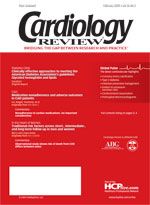Publication
Article
Cardiology Review® Online
Observational study shows risk of death from CVD differs between sexes
The last 2 decades have seen enormous strides in the identifi cation and modification of cardiovascular disease (CVD) risk factors. Many large, population-based studies, led by the Framingham Heart Study, have been invaluable in identifying these risk factors.
The last 2 decades have seen enormous strides in the identification and modification of cardiovascular disease (CVD) risk factors. Many large, population-based studies, led by the Framingham Heart Study,1 have been invaluable in identifying these risk factors. These landmark findings have enabled clinicians to aggressively treat diabetes, cholesterol, hypertension, obesity, and tobacco use in an effort to reduce the staggering rate of cardiovascular mortality both in the United States and around the world. Further studies, such as the Women’s Health Initiative,2 have drastically altered previously held notions about how to attenuate these risk factors in women and have taught us lessons about observational studies.
The Chicago Heart Association Detection Project in Industry was a large, population-based, observational cohort that enrolled 39,522 subjects aged 18 years or older working in companies in the Chicago area from November 1967 to January 1973. The study by Berry and colleagues evaluated data from 16,608 participants who were between 40 and 59 years of age, after excluding those with a history of myocardial infarction or missing baseline covariate data.3 The aim of their study was to assess whether associations between traditional risk factors change over time and whether there was a gender difference. The main finding was that women had a higher short-term increased risk of death from CVD in the setting of smoking and diabetes compared with men.
As with all observational studies, there were several limitations, including recall biases, treatment effects, and lack of proof of causality. To understand the pitfalls of observational studies, one need only recall the lessons learned from the Women’s Health Initiative, which reversed previously accepted findings of hormone replacement therapy.2 A more specific weakness of Berry and colleagues’ study is the possibility that risk factors were misclassified because subjects were only classified upon enrollment. It is well recognized that all patients with a history of smoking do not have the same cardiovascular risk, and smokers who quit shortly after enrollment would not have the same cardiovascular risk as those who continued to smoke. Risk factors should have been followed over time and reclassified as needed to more accurately assess their strength.
Despite these weaknesses, the finding of an increased risk of death from CVD in the short-term in women who have diabetes mellitus or use tobacco as compared with their male counterparts is intriguing. Is there really a pathophysiological difference between the sexes? Some previous studies have suggested that tobacco use confers an increased risk of early menopause, thereby increasing the early CVD risk.3 Observations such as these indicate that women require earlier and more aggressive risk-factor modification.
CVD is the most common cause of death among women. In an effort to address this, the American Heart Association published “A Guide to Preventive Cardiology in Women” in 1999, with a more recent update released in 2007.4 Although some gender-specific differences continue to be identified, as in this study by Berry and colleagues, the cornerstone of CVD prevention lies in identifying patients at high risk and modifying their risk factors, both in men and in women.





